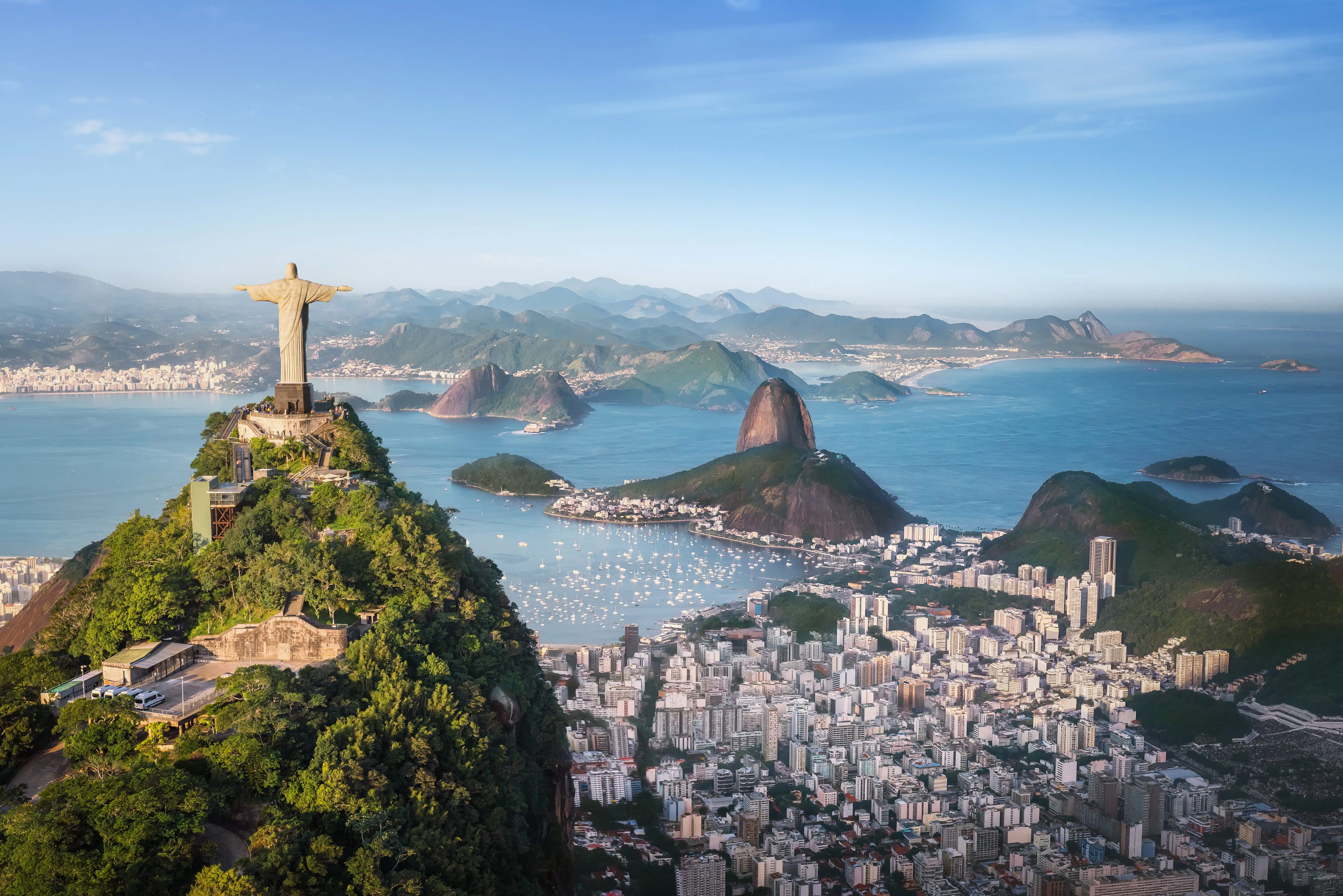Brazil, the largest country in South and Latin America, is a diverse nation with rich geographical and cultural landscapes. It spans from the Amazon Rainforest and Pantanal wetlands to the Atlantic coastline, featuring majestic waterfalls, pristine beaches, and vibrant ecosystems. Brazil’s history is marked by indigenous cultures, Portuguese colonialism, African influences, and diverse immigration, creating a unique culture evident in its architecture, music, and cuisine.
The country’s demographic diversity reflects its complex heritage, celebrated in traditions and festivals like the Carnaval, highlighting Brazil’s love for music and dance. Economically, Brazil is a resource-rich nation facing social inequality and environmental preservation challenges.
Brazilian cities range from the bustling São Paulo to historic Salvador and Ouro Preto, offering a mix of urban vibrancy and colonial history. Rio de Janeiro, known for iconic landmarks like Christ the Redeemer and Sugarloaf Mountain, showcases the country’s natural and urban beauty.
Portuguese is the official language, distinguishing Brazil from Latin America. Brazil caters to adventurers and culture enthusiasts as a destination, offering insights into its unique identity through a wide range of experiences.
1. The Amazon Rainforest
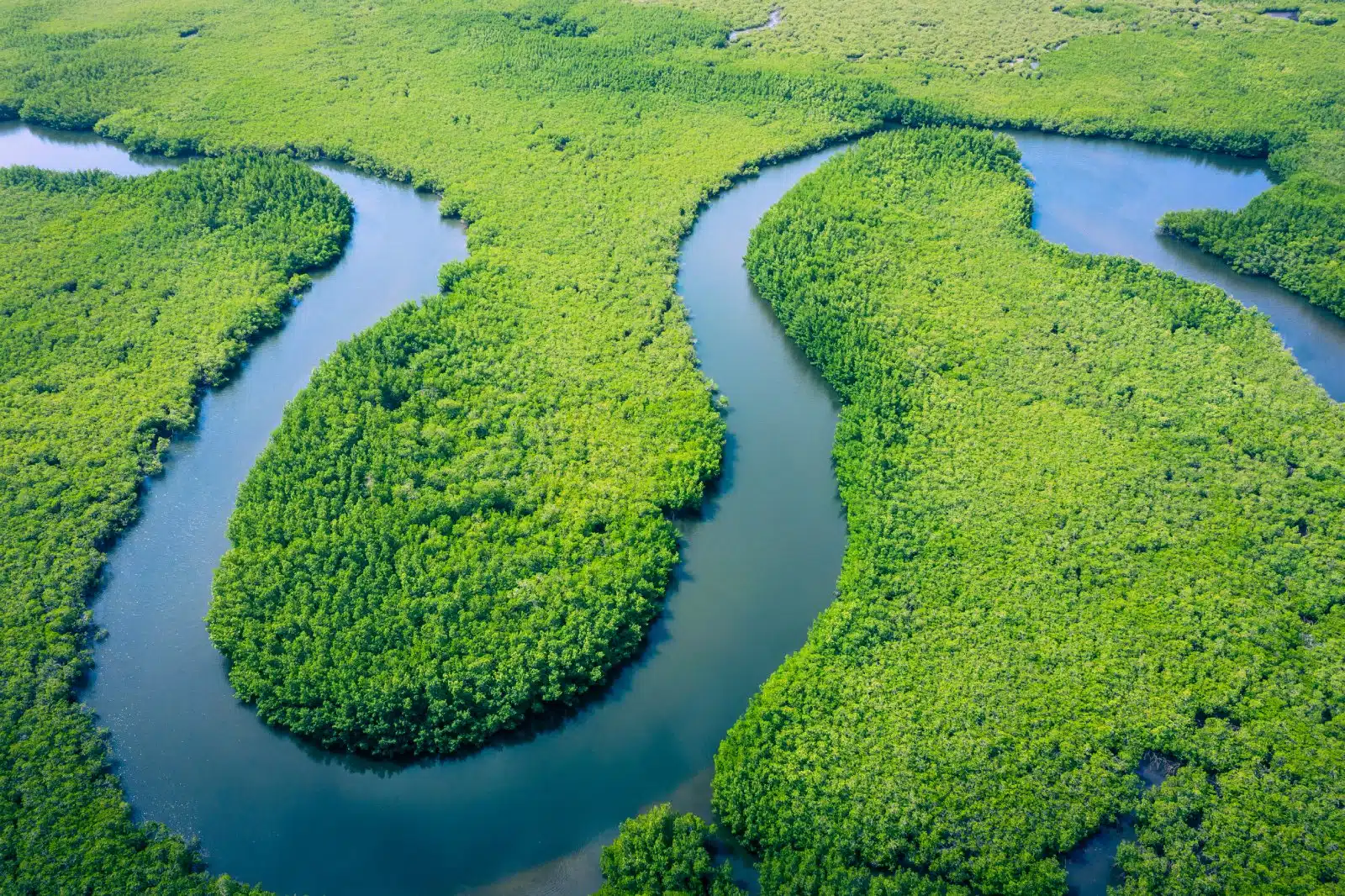
Image Credit: Shutterstock / Curioso.Photography
The Amazon Rainforest, the planet’s largest and most biodiverse tract of tropical rainforest, spans several countries, with a significant portion in Brazil. This vast green expanse is home to an unparalleled variety of wildlife, indigenous communities, and ecological wonders. Visitors can explore the Amazon River, trek through dense forests, and witness this ecosystem’s unique flora and fauna. The experience of being in the Amazon is profound, offering a close encounter with nature’s complexity and the urgent need for conservation.
Insider’s Tip: Opt for eco-friendly lodges and certified tour operators who support sustainable tourism and community projects. This ensures that your visit contributes positively to local conservation efforts and the welfare of indigenous populations.
When to Travel: The dry season from June to October is the best time to visit, as lower water levels make hiking easier and increase wildlife spotting opportunities.
How to Get There: Fly into Manaus, the gateway to the Brazilian Amazon. From there, take a riverboat or a smaller aircraft to reach your lodge or tour starting point.
2. Rio De Janeiro’s Carnaval
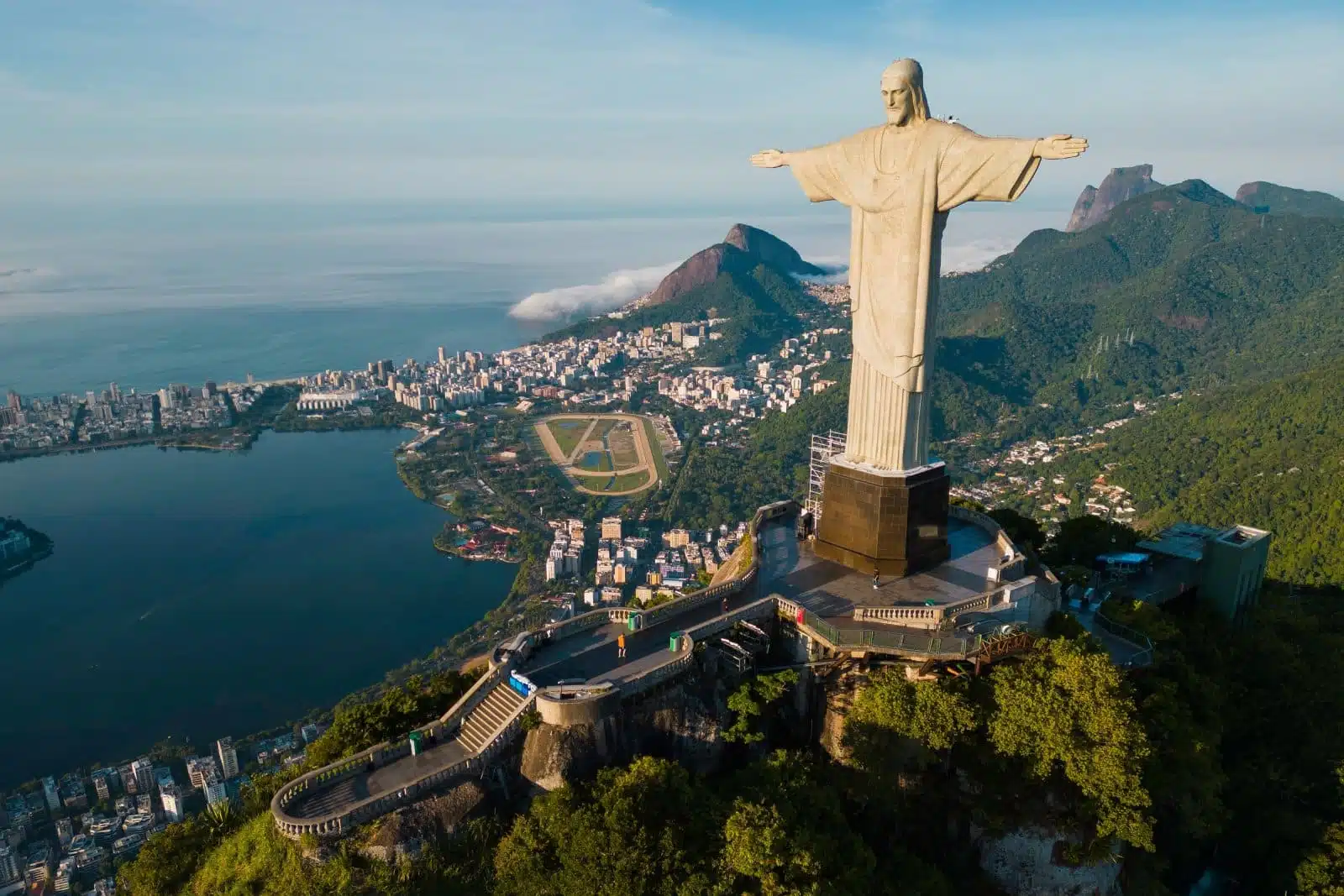
Image Credit: Shutterstock / Donatas Dabravolskas
The Carnaval in Rio de Janeiro is a world-famous festival every year before Lent. It’s a spectacular display of Brazilian culture, with vibrant parades, samba music, and dazzling costumes. The heart of the festival is the Sambadrome parade, where samba schools compete in one of the most extravagant shows on Earth. Beyond the Sambadrome, street parties (blocos) bring the city to life, offering a more accessible and spontaneous way to experience Carnaval.
Insider’s Tip: Purchase Sambadrome tickets well in advance and consider joining a bloco for a more immersive experience. Each has its own theme and music, providing a unique window into local traditions.
When to Travel: Carnaval dates vary each year but typically occur in February or early March. Plan well in advance to secure accommodations and tickets.
How to Get There: Fly into Rio de Janeiro’s Galeão International Airport. Carnaval events are citywide, with the Sambadrome located near the city center
3. Iguaçu Falls

Image Credit: Shutterstock / Nido Huebl
Straddling the border between Brazil and Argentina, Iguaçu Falls is a collection of 275 waterfalls, making it one of the most spectacular natural wonders in the world. The falls are surrounded by the lush Iguaçu National Park, a UNESCO World Heritage site that offers numerous trails and viewpoints. The Brazilian side provides panoramic views, while the Argentine side offers closer encounters with the falls. The thundering roar of water and the sight of rainbows appearing in the mist make for an unforgettable experience.
Insider’s Tip: Take a boat tour to get up close to the falls, and don’t miss the Parque das Aves, a bird park near the entrance to the falls on the Brazilian side, where you can see a variety of exotic birds up close.
When to Travel: Visit between May and September when the park is less crowded, and the weather is mild.
How to Get There: Fly into Foz do Iguaçu International Airport, located just outside the city of Foz do Iguaçu.
4. Salvador’s Pelourinho
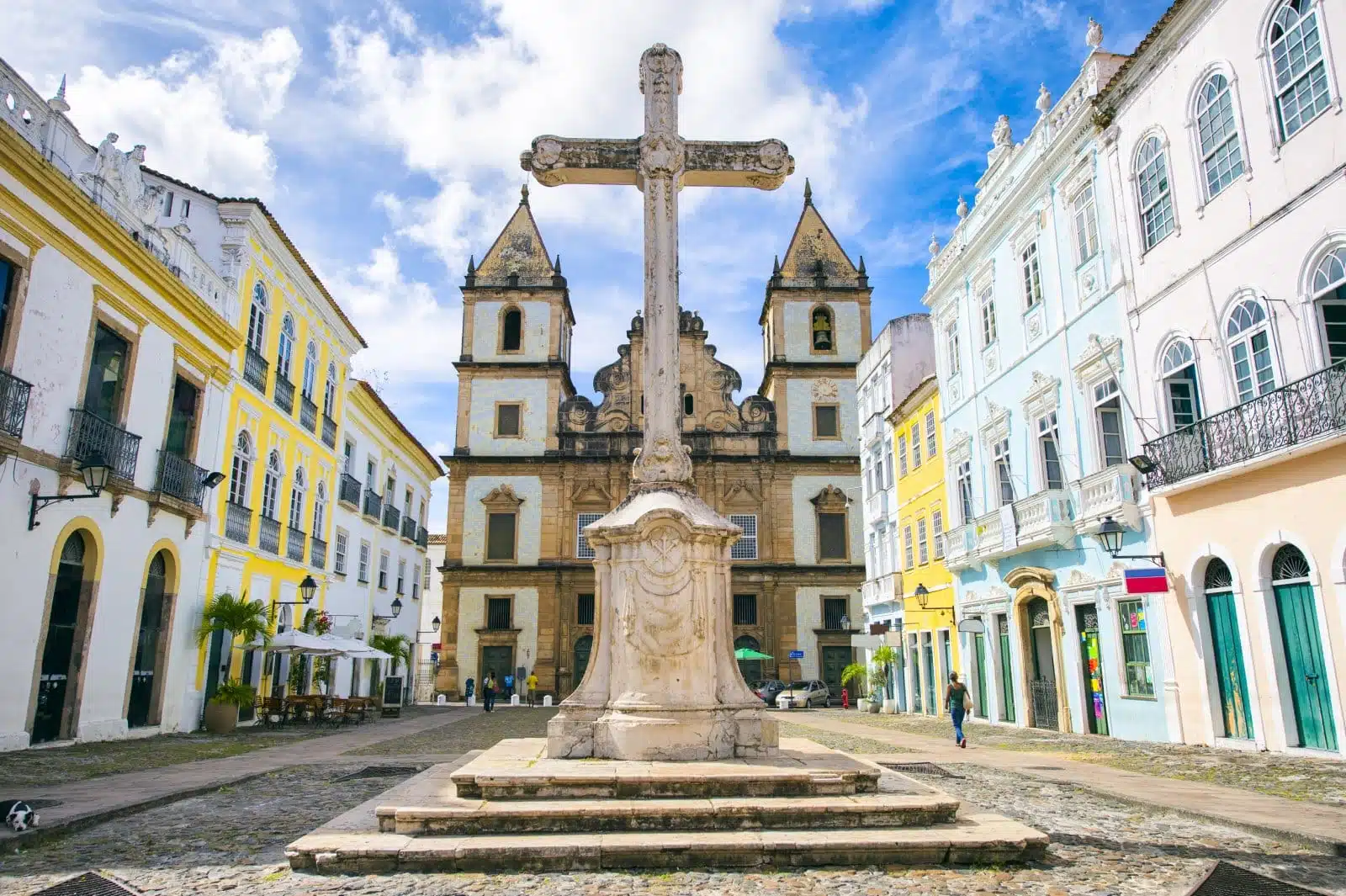
Image Credit: Shutterstock / lazyllama
Salvador, the capital of Bahia, is renowned for its Afro-Brazilian culture, and nowhere is this more evident than in Pelourinho. This historic district, a UNESCO World Heritage site, is a vibrant showcase of colonial architecture, music, cuisine, and dance. Cobblestone streets are lined with colorful buildings, churches, and museums, offering a journey through Brazil’s colonial past and African heritage. Cultural performances, including capoeira and samba, are regular occurrences, providing visitors with an engaging experience of Salvador’s living traditions.
Insider’s Tip: Visit the Afro-Brazilian Museum and take a guided walking tour to fully appreciate the historical and cultural significance of the area. Try local street food delicacies like acarajé (black-eyed pea fritters) from a Bahian vendor.
When to Travel: The best time is between December and March, when the weather is warm and the city buzzes with energy leading up to Carnaval.
How to Get There: Fly into Salvador-Deputado Luís Eduardo Magalhães International Airport, with the Pelourinho district just a short drive from the city center.
5. Pantanal Wildlife Safari
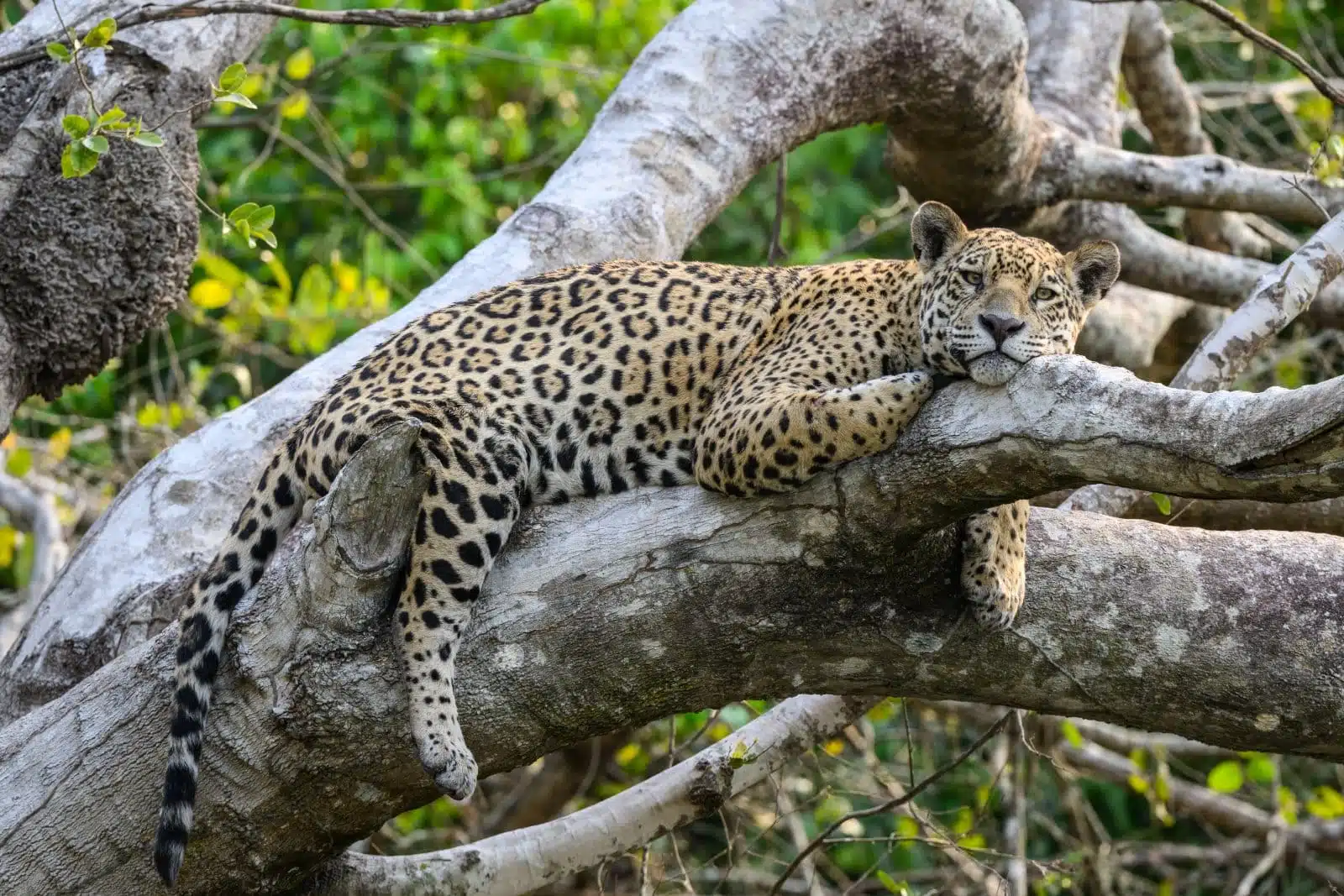
Image Credit: Shutterstock / FotoRequest
The Pantanal, the world’s largest tropical wetland area, offers some of Brazil’s best wildlife viewing opportunities. This vast, open ecosystem is home to a rich array of species, including jaguars, capybaras, caimans, and hundreds of bird species. Unlike the dense foliage of the Amazon, the Pantanal’s open landscapes make it easier to spot wildlife. Visitors can take guided tours on foot, by boat, or on horseback, providing varied perspectives of this unique ecosystem.
Insider’s Tip: For the best chance of seeing a jaguar, visit during the dry season (May to October) when animals congregate around shrinking water sources.
When to Travel: The dry season is ideal for wildlife spotting, while the wet season (November to April) offers spectacular landscapes and birdwatching.
How to Get There: Fly into Campo Grande or Cuiabá, from where you can take a smaller flight or a long drive to your lodge.
6. Ouro Preto
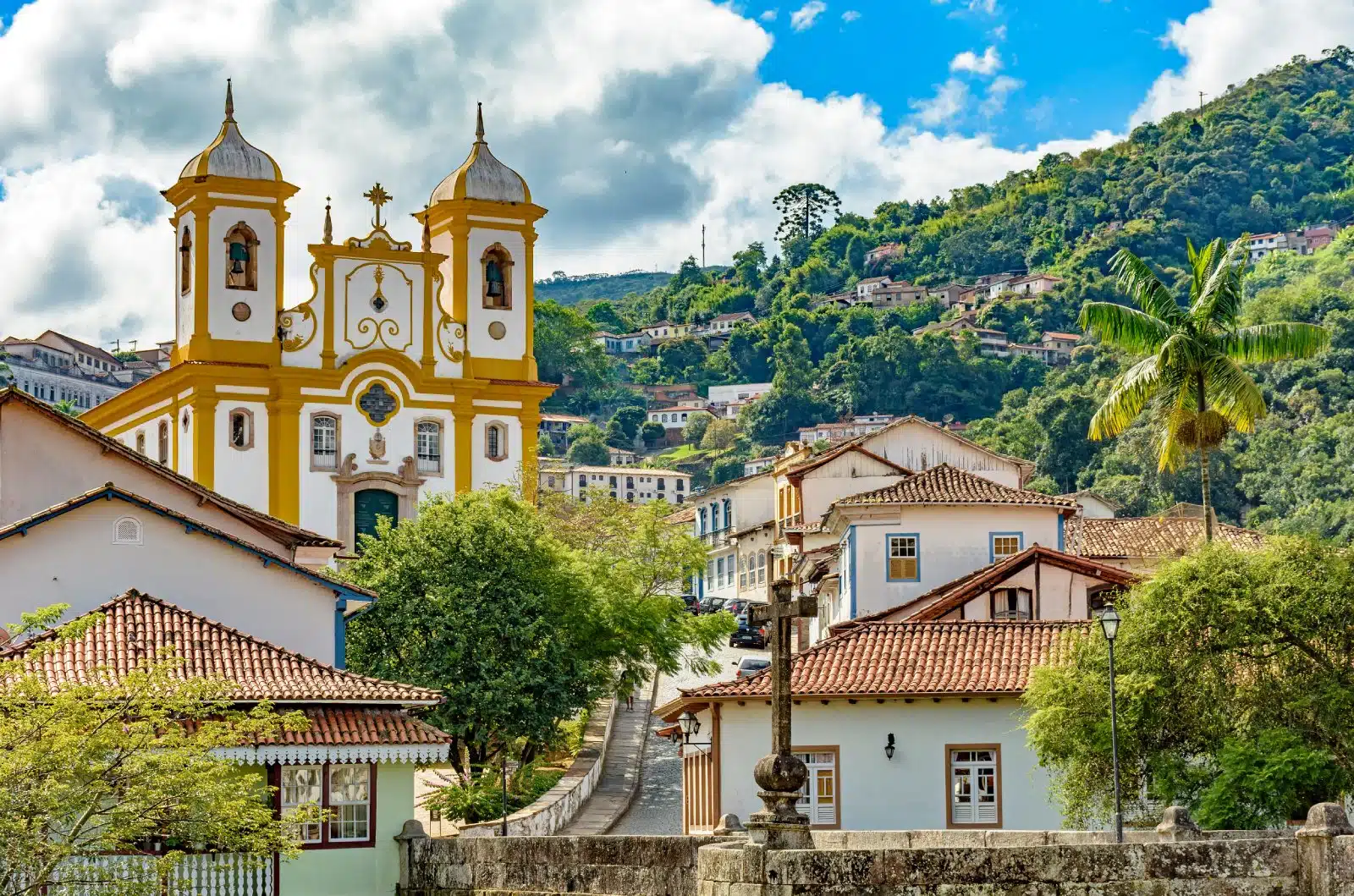
Image Credit: Shutterstock / Fred S. Pinheiro
Ouro Preto, a UNESCO World Heritage site, is a colonial town in the state of Minas Gerais, known for its baroque architecture, historic churches, and cobblestone streets. Once a center of the gold rush in the 18th century, the town offers a glimpse into Brazil’s colonial past. Museums, art galleries, and artisan workshops dot the town, showcasing its rich cultural heritage and artistic legacy. Ouro Preto’s hilly terrain offers stunning views, while its historic ambiance transports visitors back in time.
Insider’s Tip: Visit the Church of Saint Francis of Assisi to admire the work of Aleijadinho, Brazil’s most famous sculptor and architect. Also, explore the town’s local markets to find unique handcrafted items.
When to Travel: April to September offers cooler weather and less rainfall, making it ideal for exploring the town’s steep and winding streets.
How to Get There: Fly into Belo Horizonte, then drive or take a bus to Ouro Preto, about 100 kilometers away.
7. Fernando De Noronha
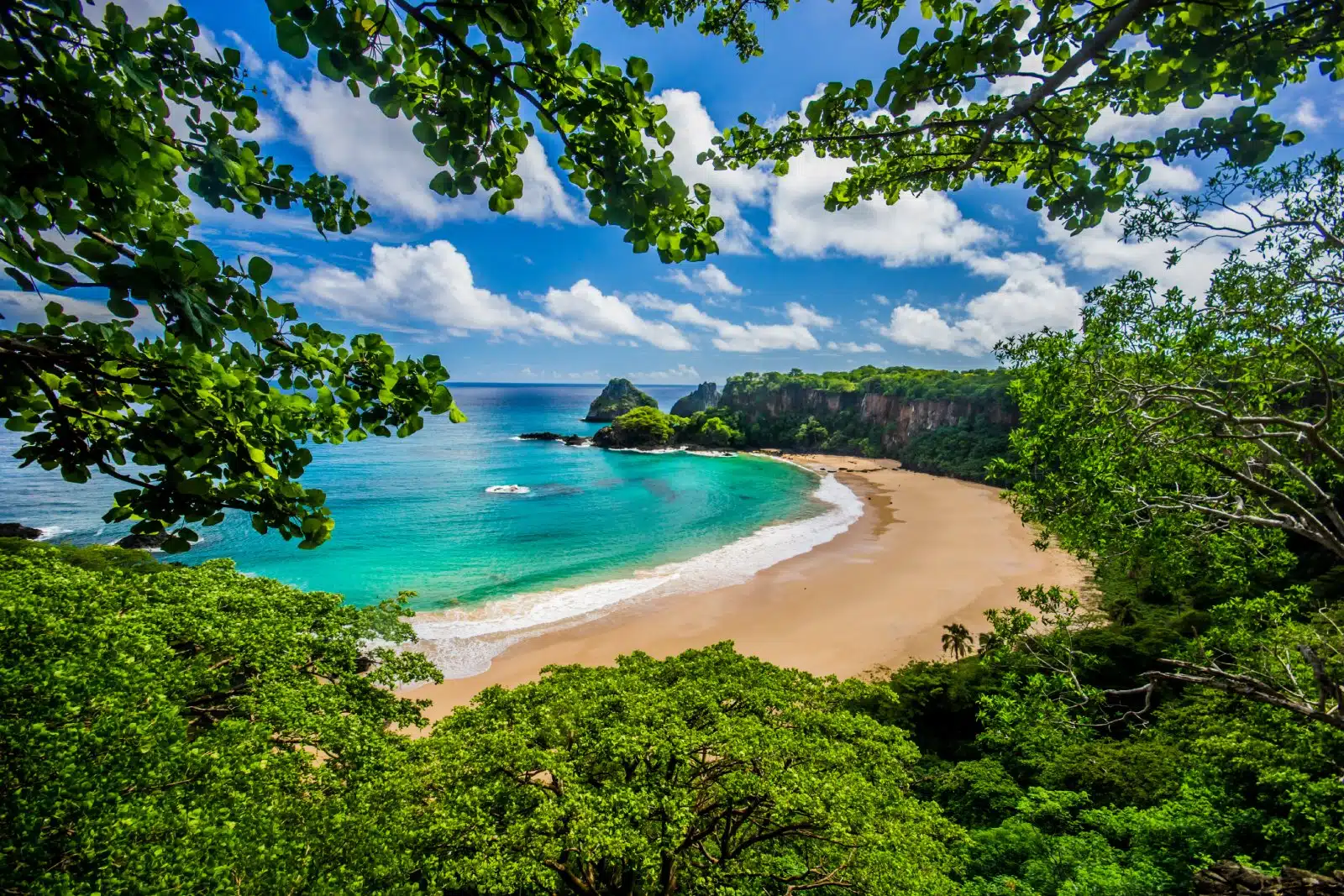
Image Credit: Shutterstock / Andre Maceira
Fernando de Noronha is an archipelago off the northeast coast of Brazil, known for its pristine beaches, clear waters, and abundant marine life. A UNESCO World Heritage site, the islands offer some of Brazil’s best diving and snorkeling, with the chance to see dolphins, turtles, and a variety of fish. The conservation efforts here ensure that the islands’ natural beauty remains protected. Visitors can enjoy hiking, surfing, and simply relaxing on the beaches, surrounded by stunning landscapes.
Insider’s Tip: Book your trip well in advance, as the number of visitors is limited to protect the ecosystem. Don’t miss the opportunity to snorkel in the crystal-clear waters of Baía do Sancho, frequently ranked among the world’s best beaches.
When to Travel: The dry season from August to January offers sunny days and calmer seas, ideal for outdoor activities.
How to Get There: Fly to Recife or Natal, then take a connecting flight to Fernando de Noronha.
8. Chapada Diamantina National Park
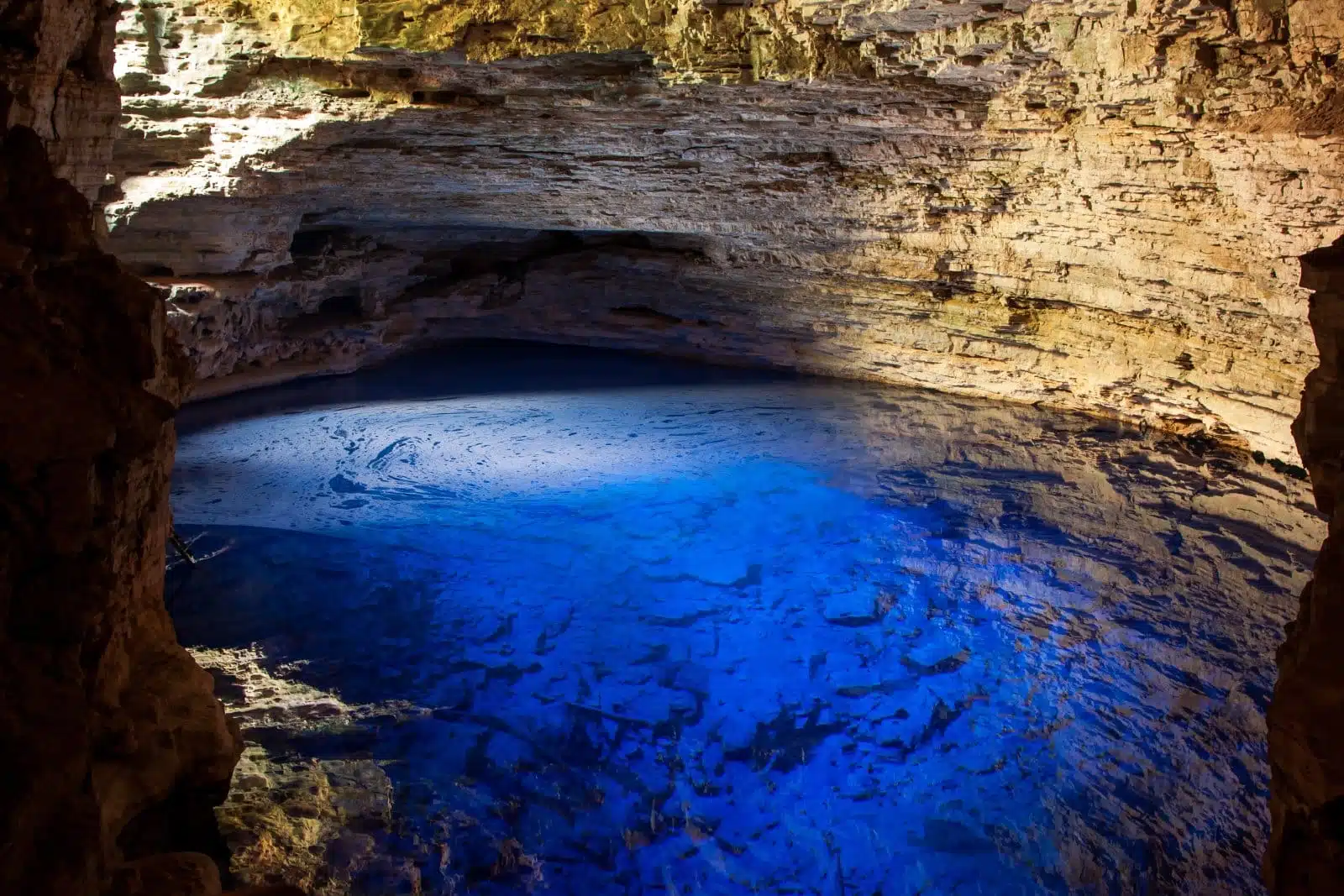
Image Credit: Shutterstock / Uwe Bergwitz
Chapada Diamantina National Park, located in Bahia, is a haven for hikers and nature lovers. The park features breathtaking landscapes of plateaus, valleys, waterfalls, and caves. Trekking paths lead to beautiful vistas, such as the Fumaça Waterfall, one of the tallest in Brazil. The park’s diverse ecosystems support a wide range of flora and fauna, making it a perfect spot for eco-tourism and adventure activities like rock climbing and cave exploring.
Insider’s Tip: Engage a local guide to explore hidden trails and learn about the park’s ecology. Be sure to visit the Poço Azul, a stunning underground pool with crystal-clear waters for a refreshing swim.
When to Travel: From May to September, the dry season is ideal for hiking and exploring, as trails are less muddy and waterfalls are less turbulent.
How to Get There: Fly into Salvador, then drive or take a bus to Lençóis, the main gateway to the park.
9. São Paulo’s Cultural Scene
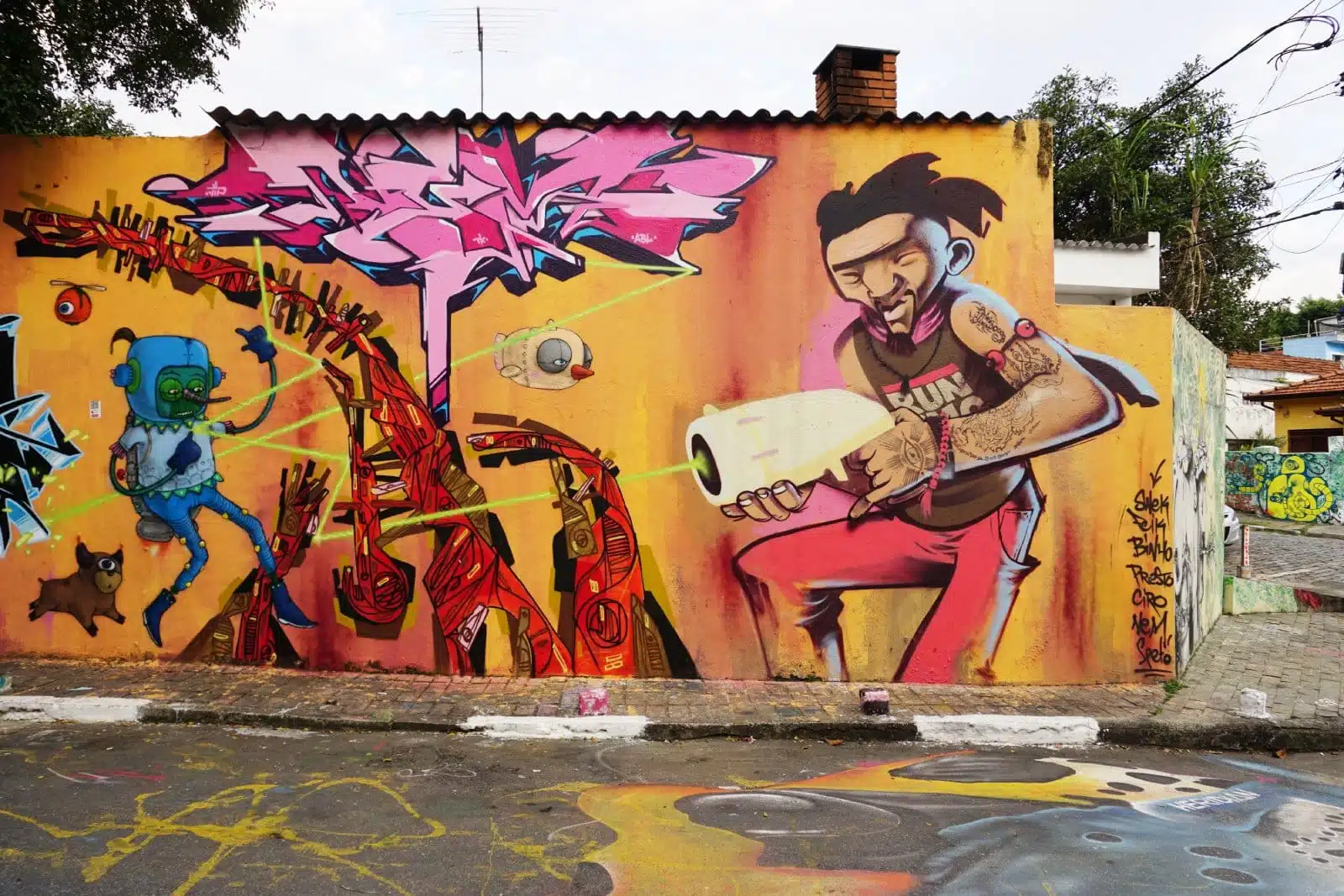
Image Credit: Shutterstock / EQRoy
São Paulo, Brazil’s largest city, is a cultural powerhouse with an unparalleled art scene, diverse culinary offerings, and vibrant nightlife. Museums like the São Paulo Museum of Art (MASP) and the Pinacoteca showcase outstanding Brazilian and international art collections. The city’s food scene ranges from street food markets to gourmet restaurants, highlighting Brazil’s culinary diversity. São Paulo is also home to a dynamic music and theater scene, hosting numerous festivals and live performances throughout the year.
Insider’s Tip: Explore the bohemian neighborhood of Vila Madalena for its street art, galleries, and bars. Don’t miss the São Paulo Biennial, one of the most important art exhibitions in the country.
When to Travel: São Paulo can be visited year-round, but March to May and October to November offer pleasant weather and fewer crowds.
How to Get There: São Paulo is well-connected by two major airports, Guarulhos International and Congonhas, making it easily accessible anywhere.
10. The Historical City of Paraty
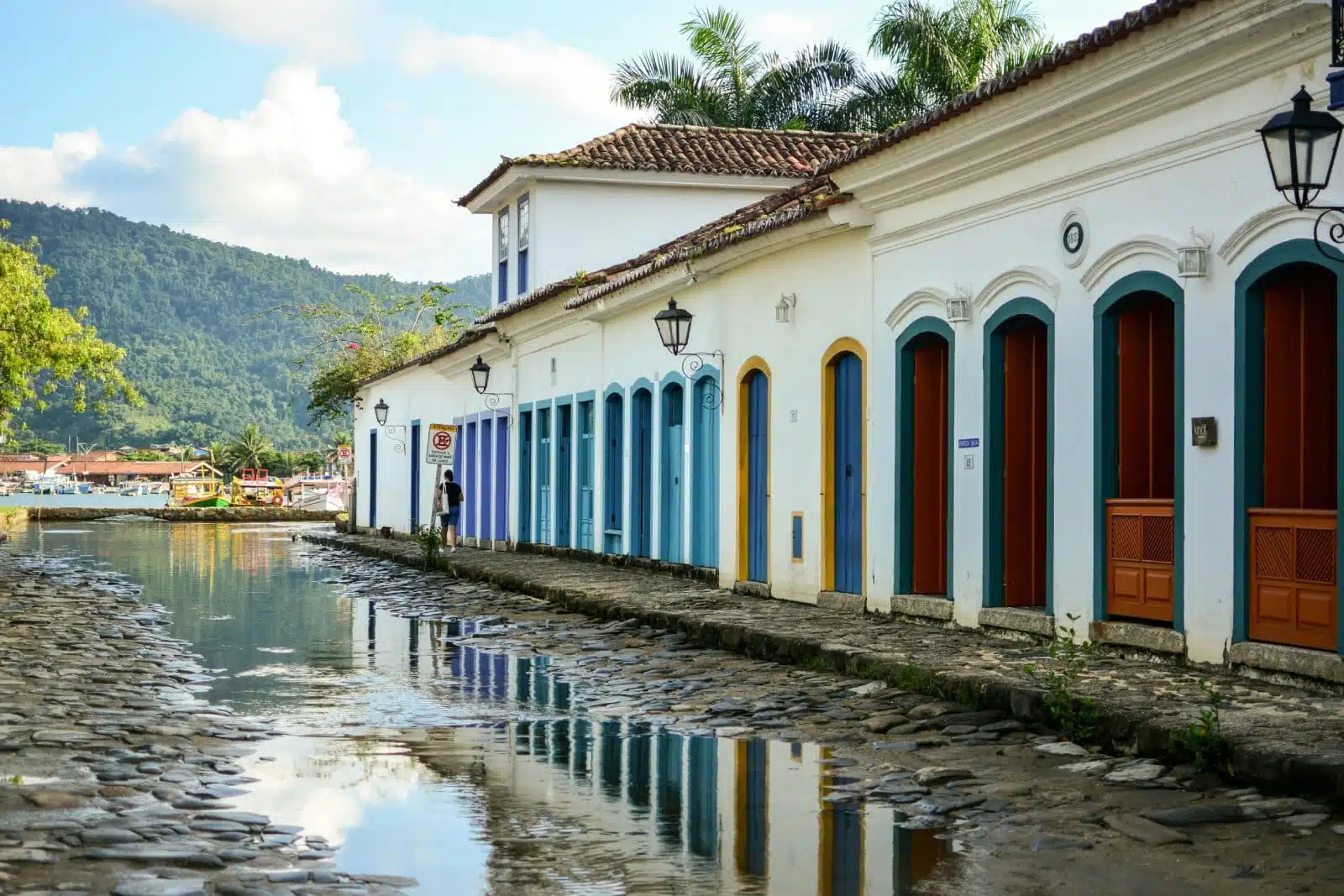
Image Credit: Pexels / isabel ph
Nestled on the Costa Verde between Rio de Janeiro and São Paulo, Paraty is a charming colonial town known for its well-preserved 17th-century architecture, cobblestone streets, and surrounding natural beauty. The town’s center is a UNESCO World Heritage site, reflecting its rich cultural and historical significance. Paraty is also a gateway to beautiful beaches and islands, offering opportunities for snorkeling, kayaking, and boat tours. The town hosts several cultural events, including the renowned Paraty International Literary Festival (FLIP).
Insider’s Tip: Take a boat tour to explore the nearby islands and secluded beaches. Visit during the week to avoid weekend crowds and fully enjoy the town’s tranquil atmosphere.
When to Travel: The best time to visit is from May to September, when the weather is dryer and cooler.
How to Get There: Fly into Rio de Janeiro or São Paulo, then drive or take a bus to Paraty, enjoying the scenic route along the coast.
11. The Lençóis Maranhenses National Park

Image Credit: Shutterstock / jocaphoto
Lençóis Maranhenses National Park in Maranhão is famous for its vast desert-like landscapes dotted with crystal-clear freshwater lagoons, formed during the rainy season. This surreal and beautiful phenomenon creates a unique ecosystem supporting diverse wildlife. Visitors can explore the park on foot or by 4×4 tours, experiencing the stark contrast of white sand dunes and sparkling blue waters, incredibly stunning at sunset.
Insider’s Tip: Plan your visit between June and September, when the lagoons are at their fullest. A guided tour can help navigate the vast park and identify the best spots for swimming and photography.
When to Travel: As mentioned, the rainy season fills the lagoons, making the mid-year months the ideal time to visit.
How to Get There: Fly into São Luís, then take a bus or a private transfer to Barreirinhas, the main gateway to the park.
12. Belém and the Ver-O-Peso Market
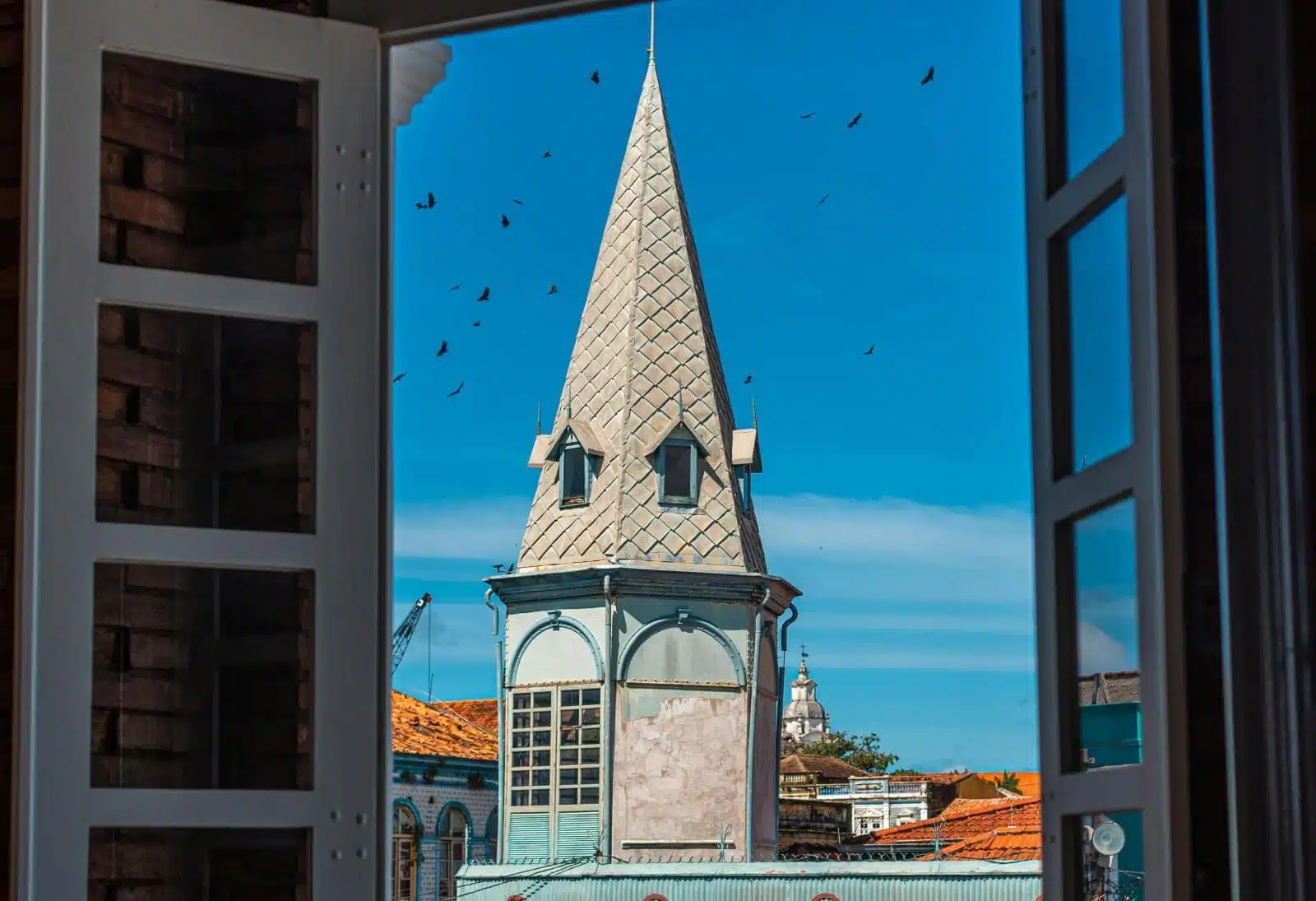
Image Credit: Pexels / Italo Melo
Belém, the gateway to the Amazon, offers a rich cultural experience with its vibrant markets, colonial architecture, and access to nearby natural attractions. The Ver-o-Peso Market is a highlight, showcasing the Amazon’s bounty with stalls selling exotic fruits, spices, and seafood. The city’s riverside location is a starting point for Amazon river cruises, offering a unique perspective on the region’s ecosystem and communities.
Insider’s Tip: Try local delicacies like açaí (served as a savory dish in Belém) and tacacá soup at the market for an authentic taste of Amazonian cuisine.
When to Travel: The dry season from June to November is best for exploring Belém and taking river cruises.
How to Get There: Fly into Belém’s Val de Cans International Airport, which has connections to major Brazilian cities and some international flights.
13. Recife and Olinda’s Carnival

Image Credit: Shutterstock / lazyllama
While Rio’s Carnaval is world-famous, Recife and its neighboring city, Olinda, host a unique and vibrant Carnival celebration known for its inclusive and diverse atmosphere. The festival features frevo music, a fast-paced rhythm unique to the region, maracatu processions, and the iconic Galo da Madrugada parade. Olinda’s historic streets come alive with traditional dances, costumes, and spontaneous parties, offering a more local and intimate Carnival experience.
Insider’s Tip: Participate in a maracatu or frevo dance workshop before Carnival to fully enjoy the experience. Visit both Recife and Olinda to witness the contrast and breadth of the celebrations.
When to Travel: Carnival takes place in February or early March. Book accommodations and flights early, as this is a peak time for visitors.
How to Get There: Fly into Recife’s Guararapes International Airport. Olinda is just a short drive from Recife, easily accessible by taxi or public transport.
14. The Wine Regions of the Serra Gaúcha

Image Credit: Shutterstock / Marina Bakush
The Serra Gaúcha in Rio Grande do Sul is Brazil’s most renowned wine region, offering a scenic landscape of rolling hills and vineyards. This region is known for producing fine wines, especially sparkling varieties. Visitors can tour vineyards, enjoy wine tastings, and learn about the winemaking process. The area also offers a rich cultural experience, with influences from German and Italian immigrants, reflected in the local cuisine and architecture.
Insider’s Tip: Plan your visit during the grape harvest (vindima) in February and March to experience the winemaking process firsthand and participate in grape-stomping events.
When to Travel: Autumn (March to May) and spring (September to November) offer mild weather, ideal for exploring the vineyards and enjoying outdoor tastings.
How to Get There: Fly into Porto Alegre, then drive or take a bus to the Serra Gaúcha region. Bento Gonçalves and Garibaldi are popular base towns for wine tourism.
15. The Amazon Theatre in Manaus
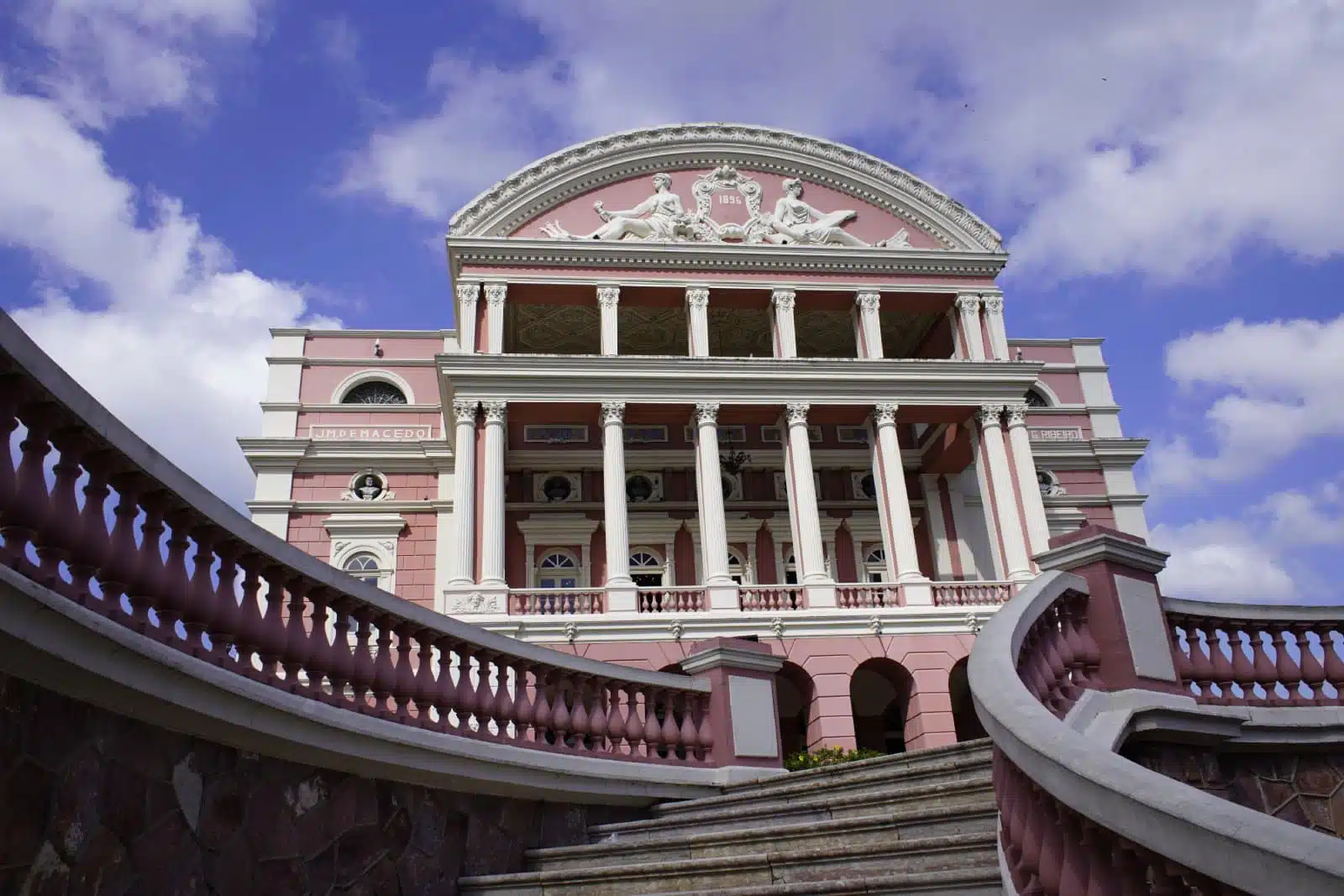
Image Credit: Shutterstock / guentermanaus
The Amazon Theatre, located in the heart of Manaus, the capital of the Amazonas state, stands as a testament to the city’s opulent past during the rubber boom of the late 19th and early 20th centuries. This historic opera house, inaugurated in 1896, is an architectural marvel, showcasing a Renaissance-style facade, domed roof, and a stunning interior adorned with murals, statues, and imported European materials. It serves as a cultural hub, hosting operas, concerts, and performances, thus keeping the region’s artistic legacy alive. The theatre is a symbol of Manaus’s rich cultural heritage and a reminder of the city’s historic significance and connection to the Amazon Rainforest.
Insider’s Tip: Attend a performance to fully experience the theatre’s acoustics and grandeur. Tours are available that provide insights into its history, architecture, and cultural significance. Plan to visit during the Amazonas Opera Festival, usually held in April or May, for a truly memorable experience.
When to Travel: Manaus is a year-round destination, but the cooler and drier months from June to September offer comfortable conditions for exploring the city and surrounding rainforest.
How to Get There: Manaus is accessible by air, with the Eduardo Gomes International Airport serving both domestic and international flights. The Amazon Theatre is located in the city center, easily reachable by taxi or public transportation from most parts of the city.
The Bottom Line

Image Credit: Shutterstock / Jonathan Borba
Exploring Brazil offers a journey through diverse landscapes, vibrant cultures, and profound historical insights. From the awe-inspiring natural wonders of the Amazon and Iguaçu Falls to the rich cultural tapestry of Salvador and Ouro Preto, each destination provides a unique glimpse into Brazil’s soul. Whether you’re seeking adventure, relaxation, or cultural enrichment, Brazil’s vast offerings ensure an unforgettable experience. Plan your visit with these insider tips, embracing the warmth and beauty of Brazil with an open heart and mind. Enjoy your travels, and let the spirit of Brazil inspire you.
More From The Green Voyage
Top 10 Trending Travel Destinations 2024
6 Essential Banking Apps for International Travel – Managing Your Finances on the Go
Traveling With Kids – 10 Tips to Create Memorable Family Holidays
The post A Country Guide to Brazil first appeared on The Green Voyage.
Featured Image Credit: Shutterstock / Diego Grandi.
For transparency, this content was partly developed with AI assistance and carefully curated by an experienced editor to be informative and ensure accuracy.
Tips for Trip Success
Book Your Flight
Find an inexpensive flight by using Kayak, a favorite of ours because it regularly returns less expensive flight options from a variety of airlines.
Book Your Hotel or Special Accommodation
We are big fans of Booking.com. We like their review system and photos. If we want to see more reviews and additional booking options, we go to Expedia.
You Need Travel Insurance!
Good travel insurance means having total peace of mind. Travel insurance protects you when your medical insurance often will not and better than what you get from your credit card. It will provide comprehensive coverage should you need medical treatment or return to the United States, compensation for trip interruption, baggage loss, and other situations.Find the Perfect Insurance Plan for Your Trip
